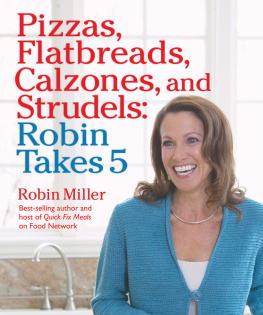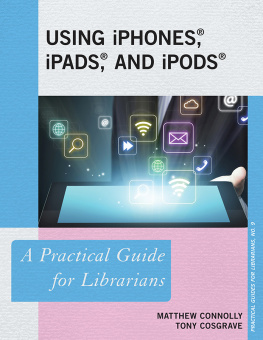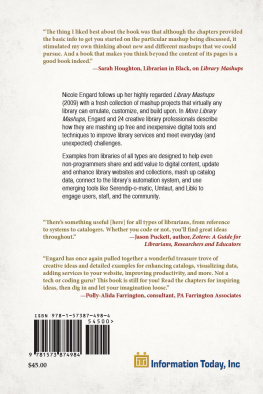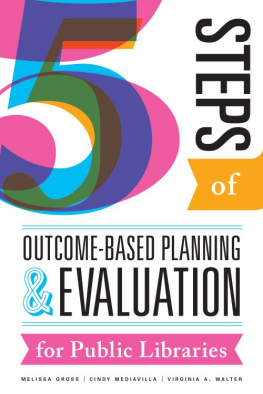MAKING SURVEYS WORK FOR YOUR LIBRARY
Guidance, Instructions, and Examples
Robin Miller and Kate Hinnant

Copyright 2019 by Robin Miller and Kate Hinnant
All rights reserved. No part of this publication may be reproduced, stored in a retrieval system, or transmitted, in any form or by any means, electronic, mechanical, photocopying, recording, or otherwise, except for the inclusion of brief quotations in a review, without prior permission in writing from the publisher.
Library of Congress Cataloging-in-Publication Data
Names: Miller, Robin, 1980 author. | Hinnant, Kate, 1970 author.
Title: Making surveys work for your library : guidance, instructions, and examples / Robin Miller and Kate Hinnant.
Description: Santa Barbara, California : Libraries Unlimited, [2019] | Includes bibliographical references and index.
Identifiers: LCCN 2018033823 (print) | LCCN 2018042586 (ebook) | ISBN 9781440861086 (ebook) | ISBN 9781440861079 (pbk. : acid-free paper)
Subjects: LCSH: Library surveys. | Library administrationDecision making.
Classification: LCC Z678 (ebook) | LCC Z678 .M49 2019 (print) | DDC 025.5/8dc23
LC record available at https://lccn.loc.gov/2018033823
ISBN: 978-1-4408-6107-9 (paperback)
978-1-4408-6108-6 (ebook)
232221201912345
This book is also available as an e-book.
Libraries Unlimited
An Imprint of ABC-CLIO, LLC
ABC-CLIO, LLC
130 Cremona Drive, P.O. Box 1911
Santa Barbara, CA 93116-1911
www.abc-clio.com
This book is printed on acid-free paper 
Manufactured in the United States of America
For John Pollitz:
What do they mean? Its not that cold in here.
Contents
Acknowledgments
Thank you to our colleagues and friends at McIntyre Library and the University of WisconsinEau Claire. If you are bemused by our enthusiasm for surveys, you are gracious editors, testers, and analysts. Thank you, also, to our survey respondentsyou have taught us more than you know.
A special thanks to our director, Jill Markgraf, for supporting us in this project. And to our colleagues Hans Kishel, Eric Jennings, and Jenna Vande Zande, for stepping in for us when we needed to work on this book.
The Value of Surveys, and Why Theyre Hard to Get Right
The 21st-century culture of librarianship is responsive and innovative; we strive to be indispensable. Librarian of Congress Dr. Carla D. Hayden, responding to a question about all the things that libraries do to serve their users, noted that the most crucial skill of a librarian is the ability to be open, to learn new things. In the broader context of technological, demographic, and budgetary changes, we gain insights into the populations we serve by asking questions that measure the present and anticipate the future. To create the libraries our patrons need, librarians are continuously learning about our users.
And we have a large constellation of library-user information, ranging from conversations with individuals, to analysis of collection usage data, to reports published by professional associations and government agencies. Surveys fit into this undertaking as one of the most efficient means of gathering information directly from library users. The best surveys offer insights that we can gain only by asking our users questions that they alone can answer. The following questions illuminate what library users do, think, want, and feel:
When deciding to attend a program, please rank the importance of the following:
Day of the week
Time of the program
Transportation available
Program topic
Please rate your satisfaction with our chat service.
What other public spaces should be added to our library?
How long are you willing to wait for a book to become available on Overdrive?
As a large-scale research method, surveys allow us to look at a question through a wide lens, collecting information about the practices and preferences of many users. When we can address a question to a large sample of library users, we may be able to generalize about their preferences for programming, services, collections, space, and more. As an instrument, the survey has the advantage that it can help a library collect a large volume of data in a relatively standardized formdata that is ripe for analysis, promising a solid foundation for decision-making. For example, a survey of a specific demographic of library users may help a library to identify the optimal time to schedule an event, like a panel discussion or a childrens story hour. A survey of library cardholders active within a particular time frame may inform decision-making about collection or service priorities. Beyond responses to a single question, surveys conducted over time can help librarians to identify trends in user preferences or behavior.
Obversely, surveys can be designed for inclusivity. Rather than surveying a population based on a defined interest, surveys distributed to a sample of a demographic group may elicit responses from infrequent library users, or those who do not go to the library at all. Surveys distributed electronically also give remote users, or patrons who use the librarys virtual services more than its physical services, a greater voice than surveys distributed exclusively to people who use the physical space. A random sample of a university student population would include nonusers, online-only users, and students whose library use varies based on their major area of study. Similarly, a public library obtaining a survey panel that includes community members outside its user database can learn about the broader perceptions and needs of these nonlibrary users.
Surveys can help librarians to test the validity of professional observations and anecdotes. For example, library administrators may notice an increasing number of questions about the availability of library spaces for public use. A survey of the librarys community or patron population might inform changes to policies or plans for renovation or expansion.
Just as a survey can be used to confirm observations and other forms of feedback, it can also put into context the prevalence of user attitudes and experiences. Squeaky wheels may or may not represent the needs or desires of other users. When the resources to respond to user wish lists are limited (as is frequently the case), surveys can help determine which interventions will be most welcome. In our experience, when we asked about the appearance of our university librarya place that several employees had decried as dingy and depressingwe learned that while no one considered the library to be attractive, the interior and exterior appearance simply didnt rate in our users minds as important or formative of a good library experience, as the few (but vocal) library staff had indicated.
Surveys are a flexible and affordable tool for gathering large quantities of data. Although questionnaires were once expensive and time consuming to administer by mail, phone, or in person, Web-based survey platforms have made surveys more accessible to librarians than ever before. The majority of library users may access surveys through e-mail and text or through library Web sites, social media, or other online promotion. Web-based survey platforms allow library staff to review data in the aggregate, and many fee-based tools even perform some basic, descriptive data analysis. For populations that would be better reached through paper surveys, their responses can be collected and integrated into the digital tool so that they can be analyzed in the aggregate.
Next page











